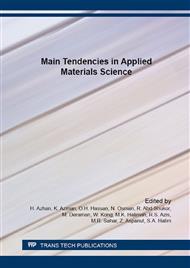p.177
p.183
p.189
p.193
p.199
p.205
p.210
p.216
p.225
Microstructure of Barium Cerate-Zirconate Ceramics Prepared by a Two-Step Sintering Technique
Abstract:
Ceramic materials based on cerate-zirconates have potential application as a solid electrolyte in electrochemical devices such as fuel cells and hydrogen sensors. To become a good electrolyte, the material must exhibits high density sample with homogenize grain size. In this study, we systematically investigated the microstructure of Ba (Ce,Zr)O3 pellet as a function of sintering temperature. The calcined powder was compressed to become a pellet using hydraulic press with pressure of 5 tons for 5 min. Two-step sintering (TSS) process was applied for the densification of Ba (Ce,Zr)O3 pellet. The first temperature profile was fixed at T1 = 1400°C and the second temperature profile was varied from T2 = 1150°C, 1200°C, 1250°C, 1300°C and 1350°C, respectively. The sintered sample at T2 = 1350°C showed the highest density compared to others. Its relative density was 82.50%. The lowest density was 64.38% for the sintered sample at T2 = 1150°C. However, the densification of pellet showed an irregular behavior at T2 = 1300°C. It might be related to the de-densification phenomenon due to the presence of carbonate species in the calcined powder. Microstructure of the fracture sintered pellet as observed by a scanning electron microscope (SEM) showed the grain size of the samples was in the range of 149.2–336.4 nm. For a comparison, green pellet and pellet prepared with conventional sintering step (CSS) were also discussed in this study.
Info:
Periodical:
Pages:
199-204
Citation:
Online since:
March 2016
Authors:
Keywords:
Price:
Сopyright:
© 2016 Trans Tech Publications Ltd. All Rights Reserved
Share:
Citation:


